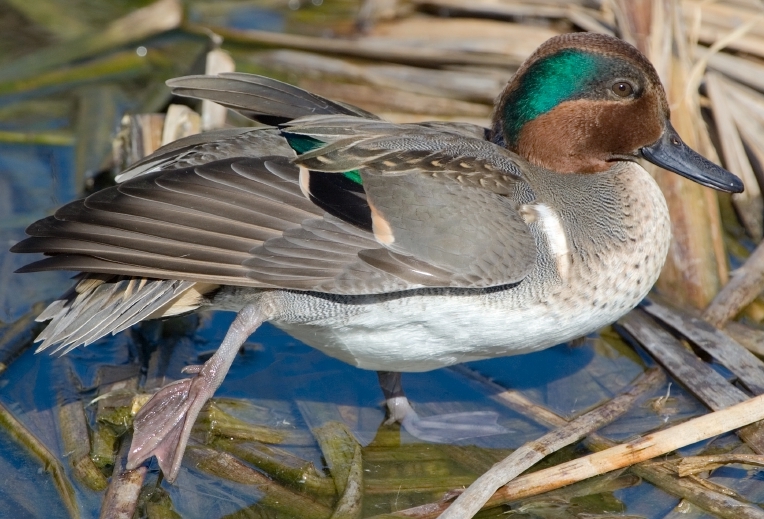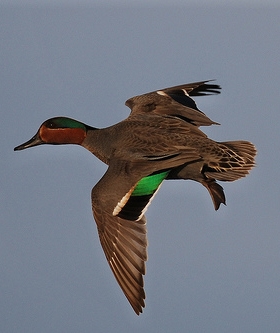Wildlife - Species
Green-winged Teal (Anas crecca)
Description
Green-winged teals belong to the family Anatidae, which includes ducks, swans, and geese. Similar to other duck species, green-winged teals exhibit marked sexual dimorphism; that is, males and females look different, with males typically more brightly colored. Male green-winged teals have chestnut heads with a dark green ear patch. Their sides are a pale gray color, and their breast is pinkish with a white stripe down the side. Females are mottled light to dark brown with a white underside. These small, 35 cm (14 in) long ducks are agile and quick in flight. They are similar in appearance to blue-winged teals, but the latter have pale blue shoulder patches.
Preferred Habitat and Biology
Over-wintering green-winged teals reside throughout most of the southern two thirds of the continental United States, including all of South Carolina. They prefer riparian areas such as saltwater and freshwater marshes, lakes, ponds, streams, and waterfowl impoundments in the ACE Basin.
Green-winged teals nest in well-hidden, shallow, down-lined scrapes in grassy areas. They produce one brood per year, with the female laying an average of 8-9 eggs. Male ducks leave prior to incubation, so only females incubate the eggs for a period of 21-23 days. Young can fly after 34 days and have one of the fastest growth rates of North American ducks. This species is well known for its wheeling mass flights similar to a flock of sandpipers. Teals eat aquatic invertebrates, tadpoles, seeds, and aquatic vegetation.
Species Significance
Green-winged teals are popular game birds throughout their range due to their quick flight. They are one of the fastest flying ducks. South Carolina Department of Natural Resources determines dates for the hunting season each year (available in SCDNR's Waterfowl Hunting Regulations). Green-winged teals are not threatened or endangered.
References
Bull, J. L. and J. Farrand, Jr. 1995. National Audubon Society Field Guide to North American Birds. Eastern Region. The Audubon Society field guide series. Alfred A. Knopf Inc., New York, NY.
Ehrlich, P. R., D. S. Dobkin, and D. Wheye. 1988. The birder's handbook: A field guide to the natural history of North American birds, including all species that regularly breed north of Mexico. Simon & Schuster, New York, NY.
National Geographic Society. 1987. Field guide to the birds of North America. Second edition. National Geographic Society, Washington, DC.
Sprunt, A., Jr. and E. B. Chamberlain. 1970. South Carolina bird life. University of South Carolina Press, Columbia, SC.



